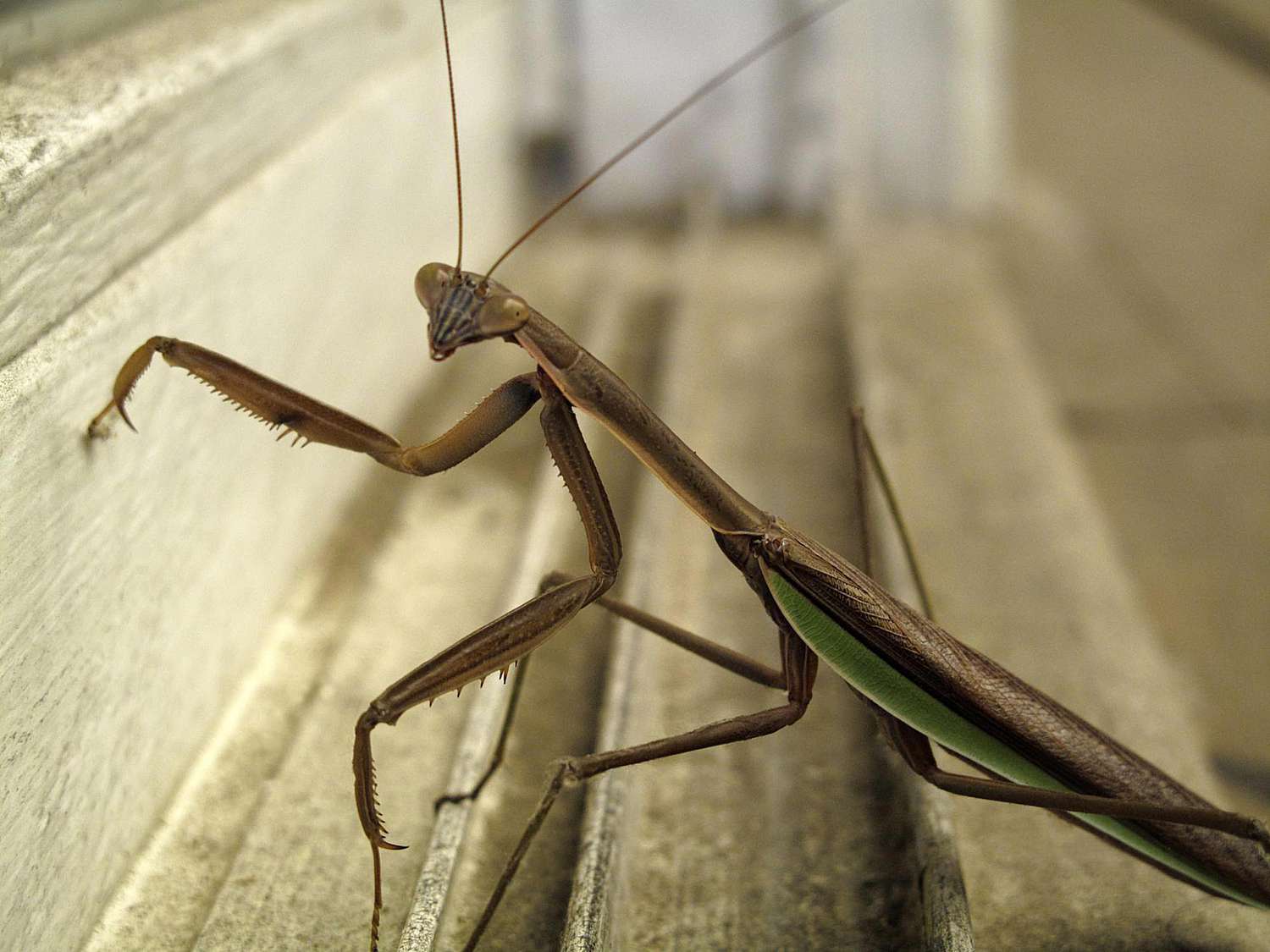Home>Gardening News and Trends>Latest News>Which Marigolds Repel Insects


Latest News
Which Marigolds Repel Insects
Modified: January 22, 2024
Discover the latest news on which marigolds have the natural ability to repel insects. Learn about the most effective varieties to keep your garden pest-free.
(Many of the links in this article redirect to a specific reviewed product. Your purchase of these products through affiliate links helps to generate commission for Chicagolandgardening.com, at no extra cost. Learn more)
Table of Contents
- Introduction
- What are marigolds?
- Benefits of using marigolds as insect repellents
- Types of insects repelled by marigolds
- How do marigolds repel insects?
- Best varieties of marigolds for insect repellent
- Planting marigolds for insect control
- Tips for maximizing the insect-repellent properties of marigolds
- Conclusion
Introduction
When it comes to natural pest control in the garden, marigolds are a popular choice. These vibrant and aromatic flowers not only add beauty to your garden but also have the incredible ability to repel insects. Whether you’re dealing with pesky mosquitoes, aphids, or nematodes, marigolds can be a valuable ally in your battle against garden pests.
Marigolds are a type of flowering plant that belongs to the Tagetes genus. They are native to the Americas and are widely cultivated around the world for their ornamental and medicinal properties. Marigolds come in various sizes and colors, including yellow, orange, and red. Their distinctive scent is what sets them apart from other plants, making them a natural insect repellent.
The use of marigolds as insect repellents has been known for centuries, with traditional gardeners planting them alongside vegetables and herbs to deter pests. In recent years, scientific studies have confirmed the effectiveness of marigolds in repelling insects. This natural method of pest control is not only eco-friendly but also avoids the use of harmful chemicals found in many conventional insecticides.
Marigolds emit a strong aroma that repels a wide range of insects. This is due to the presence of certain compounds, such as thiophenes, limonene, and alpha-pinene, which are known to repel pests. These compounds act as a natural barrier, keeping insects at bay and protecting your plants from damage.
Not only do marigolds repel insects, but they also attract beneficial insects like ladybugs, hoverflies, and parasitic wasps that feed on garden pests. This creates a balanced ecosystem in your garden, where the beneficial insects help control the population of harmful pests, minimizing the need for chemical intervention.
If you’re looking for a natural and effective way to repel insects in your garden, marigolds are a fantastic option. In the following sections, we’ll explore the specific types of insects that marigolds repel, how they achieve this, and the best varieties of marigolds to use for insect control.
What are marigolds?
Marigolds are beautiful, flowering plants that belong to the Tagetes genus. They are native to the Americas and are widely cultivated for their vibrant colors and strong fragrance. Marigolds have been popular garden plants for centuries due to their ornamental value and their ability to repel insects.
There are several different species of marigolds, including Tagetes erecta (African marigold), Tagetes patula (French marigold), and Tagetes tenuifolia (Signet marigold). African marigolds are known for their tall, upright growth and large, pom-pom-like flowers. French marigolds are more compact with smaller, daisy-like flowers. Signet marigolds have ferny foliage and smaller, single flowers.
Marigolds are annual plants, meaning they complete their life cycle in one growing season. They have a relatively short lifespan, typically flowering from spring to fall. However, they are easy to grow from seeds or transplants and can quickly fill your garden with their cheerful blooms.
In addition to their striking appearance, marigolds are valued for their strong fragrance. The flowers produce a pungent, musky scent that is distinctively marigold. This aroma is not only pleasant to humans but also acts as a natural repellent to many insects.
Marigolds are also highly adaptable plants that can thrive in various growing conditions. They prefer full sun and well-draining soil, but they can tolerate some shade and less than ideal soil conditions. This makes them suitable for gardens of all sizes and types, from large flower beds to container gardens or even hanging baskets.
Aside from their insect-repellent properties, marigolds have also been used for medicinal purposes. The flowers contain compounds that have anti-inflammatory and antibacterial properties, making them a popular ingredient in traditional medicine.
With their vibrant colors, strong fragrance, and natural insect-repelling abilities, marigolds are a fantastic addition to any garden. Whether you’re looking to beautify your outdoor space or protect your plants from pests, marigolds are a versatile and valuable plant to have.
Benefits of using marigolds as insect repellents
Using marigolds as insect repellents in your garden offers numerous benefits. These lovely flowers not only create a beautiful and vibrant atmosphere but also provide natural protection against a wide range of pests. Let’s explore the key advantages of using marigolds as insect repellents.
1. Natural pest control: One of the biggest benefits of using marigolds as insect repellents is that they offer natural pest control without the need for harmful chemicals. Many conventional insecticides contain toxic ingredients that can harm beneficial insects, birds, and even humans. Marigolds provide a safer alternative that allows you to protect your plants and the environment simultaneously.
2. Effective against various pests: Marigolds have been found to repel a variety of pests, including mosquitoes, aphids, whiteflies, nematodes, and even rabbits. Planting marigolds in and around your garden can help deter these unwanted visitors, reducing the damage they cause to your plants.
3. Attract beneficial insects: While marigolds repel harmful insects, they also attract beneficial insects like ladybugs, hoverflies, and parasitic wasps. These beneficial insects feed on garden pests, keeping their populations in check and reducing the need for additional pest control methods. By cultivating marigolds, you can create a balanced ecosystem in your garden.
4. Affordable and low-maintenance: Marigolds are cost-effective and easy to grow, making them an excellent option for gardeners of all skill levels. They can be easily propagated from seeds or transplants, and they require minimal care once established. This makes marigolds a convenient and budget-friendly choice for natural pest control.
5. Versatile uses: Marigolds can be used in various ways to repel insects. You can plant them in flower beds, border gardens, or containers. They can also be interplanted with vegetables, herbs, and other flowering plants to provide natural protection against pests. Additionally, dried marigold flowers can be used as insect-repellent sachets or added to homemade pest control sprays.
By harnessing the insect-repellent properties of marigolds, you can maintain a healthy and pest-free garden without resorting to synthetic pesticides. Not only will you protect your plants and the environment, but you’ll also enjoy the added beauty and aroma that marigolds bring to your outdoor space.
Types of insects repelled by marigolds
Marigolds have a remarkable ability to repel a wide range of insects, making them a valuable addition to your garden. Let’s explore the various types of pests that marigolds can help deter.
1. Mosquitoes: The strong scent of marigolds acts as a natural mosquito repellent. Mosquitoes are attracted to the carbon dioxide and body heat emitted by humans, but the scent of marigolds confuses and repels them, reducing the likelihood of mosquito bites in your outdoor space.
2. Aphids: Aphids are small, sap-sucking insects that can cause significant damage to plants by feeding on their leaves and stems. Marigolds release a chemical compound called limonene, which repels aphids. Planting marigolds near susceptible plants can help protect them from aphid infestations.
3. Whiteflies: Whiteflies are tiny, winged insects that feed on plant sap and can quickly multiply, leading to stunted growth and yellowing leaves. Marigolds emit a pungent scent that repels whiteflies, reducing their invasion and protecting your plants from their damaging feeding habits.
4. Nematodes: Nematodes are microscopic roundworms that burrow into plant roots and cause root knot galls, ultimately impacting the plant’s health. Certain varieties of marigolds, such as the African marigold (Tagetes erecta), release natural compounds that repel nematodes, preventing their entry into the root system of vulnerable plants.
5. Rabbits: Marigolds can also help deter rabbits, which are known to munch on garden plants and vegetables. The strong scent of marigolds can act as a deterrent, making your garden less appealing to these furry intruders.
While these are some of the main types of insects repelled by marigolds, it’s important to note that their effectiveness can vary depending on the specific species and variety of marigolds, as well as the severity of the pest problem. Additionally, marigolds may not completely eliminate pest issues but can significantly reduce their impact.
By including marigolds in your garden, you can create a more inhospitable environment for these pests, helping to protect your plants and promote a healthier, pest-resistant garden.
How do marigolds repel insects?
Marigolds possess natural compounds that help repel insects. These compounds work together to create a hostile environment for pests. Here’s a closer look at how marigolds repel insects:
1. Strong scent: Marigolds emit a distinct and strong fragrance that many insects find unpleasant. The primary compounds responsible for this scent include thiophenes, limonene, and alpha-pinene. These compounds act as natural repellents, making the area around marigolds less desirable to insects.
2. Masking effect: Marigold scent also has the ability to mask the scent of nearby plants that attract pests. Insects rely on scents to navigate and locate their food sources. The strong scent of marigolds can confuse insects, making it difficult for them to locate their preferred plants and disrupting their feeding patterns.
3. Visual deterrent: Marigolds’ vibrant and colorful flowers can act as a visual deterrent to some insects, such as aphids and whiteflies. These pests are naturally attracted to certain colors and patterns in plants. The bright colors of marigolds may confuse or repel them, reducing their likelihood of infestation.
4. Companion planting: Marigolds are often used as companion plants in vegetable gardens. When planted alongside vegetables or other susceptible plants, marigolds can help protect them by creating a barrier. The scent and compounds released by marigolds act as a natural shield, discouraging pests from approaching nearby plants.
5. Attracting beneficial insects: Marigolds not only repel harmful insects but also attract beneficial insects. Ladybugs, hoverflies, and parasitic wasps are all attracted to marigolds’ nectar and pollen. These beneficial insects feed on garden pests, helping to reduce their population naturally and maintaining a balance in the garden ecosystem.
It’s important to note that the degree of repellency can vary depending on the specific species and variety of marigolds, as well as the type of pest. Planting marigolds strategically and maintaining a healthy garden environment can maximize their insect-repellent properties.
Overall, marigolds’ fragrance, visual characteristics, and companion planting benefits combine to make them effective at repelling insects and protecting your plants from infestations.
Best varieties of marigolds for insect repellent
When it comes to selecting marigolds for their insect-repellent properties, certain varieties have proven to be particularly effective. These varieties contain higher concentrations of the compounds that repel pests. Here are some of the best varieties of marigolds for insect repellent:
1. Tagetes erecta (African marigold): African marigolds are known for their large, pom-pom-like flowers and strong fragrance. They are particularly effective at repelling insects like aphids, whiteflies, and nematodes. Their robust growth habit and vibrant colors make them a standout choice in any garden.
2. Tagetes patula (French marigold): French marigolds are smaller in size compared to African marigolds but still possess excellent insect-repellent properties. They are highly effective at repelling aphids and whiteflies, making them an ideal choice for protecting vegetables and herbs from these pests. French marigolds come in a range of colors, including yellow, orange, and red, adding a pop of color to your garden.
3. Tagetes tenuifolia (Signet marigold): Signet marigolds have delicate, ferny foliage and small, single flowers. They are known for their abundant and long-lasting blooms. Signet marigolds emit a strong fragrance that repels insects like aphids and whiteflies. These marigolds are also edible, adding a flavorful twist to salads and other dishes.
4. The “Lemon Gem” variety: Lemon Gem marigolds, a type of signet marigold, are particularly renowned for their lemon-scented foliage and flowers. Their citrusy scent repels a wide range of pests, including mosquitoes and aphids. The cheerful yellow flowers of Lemon Gem marigolds brighten up any garden space.
5. The “Tangerine Gem” variety: Tangerine Gem marigolds, another type of signet marigold, have vibrant orange flowers and a lovely fragrance. They are effective at repelling aphids, making them a great companion plant for vegetables like tomatoes and peppers. Tangerine Gem marigolds also attract beneficial insects, such as hoverflies and parasitic wasps.
When choosing marigolds for their insect-repellent properties, opt for varieties that have a strong fragrance and vibrant colors. You can start them from seeds or purchase young plants from nurseries or garden centers. Plant them strategically throughout your garden to create a barrier against pests and protect your plants.
Remember to consider the specific needs and characteristics of each variety to ensure they thrive in your garden. With the right selection of marigold varieties, you can enjoy a pest-free garden while adding beauty and fragrance to your outdoor space.
Planting marigolds for insect control
Planting marigolds strategically in your garden is an effective way to control pests and minimize the use of chemical insecticides. Here are some tips to keep in mind when planting marigolds for insect control:
1. Choose the right location: Marigolds thrive in full sun, so select a location in your garden that receives at least 6-8 hours of direct sunlight daily. Ensure that the soil is well-draining to prevent waterlogged conditions, which can lead to root rot. Prepare the soil by loosening it and removing any weeds or debris.
2. Consider companion planting: Marigolds work exceptionally well when planted alongside susceptible plants. Their insect-repellent properties can act as a barrier, protecting nearby plants from pests. Some ideal companions for marigolds include tomatoes, peppers, cabbage, broccoli, and herbs like basil and rosemary.
3. Determine the spacing: Proper spacing is essential for the healthy growth of marigolds and to maximize their insect-repellent properties. Space the plants at least 12-18 inches apart to allow for good air circulation. This helps prevent the spread of diseases and ensures that the marigolds receive adequate sunlight and nutrients.
4. Prepare the planting holes: Dig holes that are slightly larger than the root ball of the marigold plants. Place the plants in the holes, ensuring that the top of the root ball is level with the soil surface. Backfill the holes with soil and gently press it down around the plants to secure them in place.
5. Water regularly: After planting, water the marigolds thoroughly to help them establish their root system. Once established, marigolds are relatively drought-tolerant and don’t require excessive watering. However, water them regularly during dry periods to maintain their overall health and prevent stress.
6. Deadhead regularly: Deadheading, or removing spent flowers, not only keeps your marigolds looking tidy but also encourages the plants to produce more blooms. Regular deadheading redirects the plant’s energy toward new growth and flower production, allowing you to enjoy an abundance of insect-repellent blooms throughout the growing season.
7. Monitor for pests: While marigolds are effective at repelling insects, it’s important to monitor your garden regularly for any signs of pest infestation. Even with marigolds present, some pests may occasionally appear. Swiftly address any pest issues using organic pest control methods or by attracting beneficial insects to help control the pests naturally.
By following these planting tips, you can successfully incorporate marigolds into your garden to help control pests. Not only will you maintain a healthier and more vibrant garden, but you’ll also create a welcoming environment for beneficial insects, promoting a balanced ecosystem in your backyard.
Tips for maximizing the insect-repellent properties of marigolds
To get the most out of the insect-repellent properties of marigolds, there are several tips you can follow to maximize their effectiveness. By implementing these strategies, you can ensure that your marigolds are working their best to protect your garden from pests:
1. Plant in abundance: To create a strong deterrent effect, plant marigolds in large groups or clusters rather than scattering them sparsely throughout your garden. The concentrated presence of marigolds will release a higher concentration of the natural compounds that repel insects, making the area less appealing to pests.
2. Utilize different marigold varieties: Incorporate multiple varieties of marigolds in your garden, including African marigolds, French marigolds, and signet marigolds. Different varieties may have varying levels of effectiveness against different pests. By combining different varieties, you can cover a broader spectrum of potential insect threats.
3. Choose scented varieties: Opt for marigold varieties that have a strong fragrance, as the scent is a key factor in their insect-repellent properties. The stronger the fragrance, the better the marigolds will be at repelling insects. Look for varieties like Lemon Gem or Tangerine Gem, which have a distinct citrus scent.
4. Rotate marigolds with other plants: Consider rotating your marigolds with other plants each growing season. This helps prevent pests from becoming accustomed to the scent and repelling effects of marigolds. By periodically switching the location of your marigolds, you maintain their effectiveness at deterring pests.
5. Deadhead regularly: As flowers begin to fade, make sure to deadhead or remove them promptly. Deadheading encourages the production of new flowers and prevents marigolds from going to seed too soon. This allows the plants to continue releasing their insect-repellent compounds throughout the growing season.
6. Maintain good plant health: Keep your marigolds healthy by providing them with proper care. Ensure they receive adequate sunlight, water them regularly, and maintain a well-drained soil environment. Healthy marigolds are better equipped to ward off pests and are more likely to thrive, providing you with maximum insect-repellent properties.
7. Incorporate other pest control methods: While marigolds are effective at repelling insects, they may not completely eliminate pest problems. Consider integrating other pest control methods, such as companion planting with pest-resistant plants, regular inspection and removal of infested plants, and applying organic pest control products when necessary.
By following these tips, you can enhance the insect-repellent properties of your marigolds, creating a powerful defense against pests in your garden. With proper care and strategic utilization of marigolds, you can enjoy a healthier, more pest-resistant garden environment.
Conclusion
Marigolds have long been celebrated for their beauty in gardens, but their insect-repellent properties make them even more valuable. These vibrant flowers not only add color and fragrance to your outdoor space but also serve as a natural defense against pests. By incorporating marigolds into your garden, you can minimize the need for harmful chemicals and create a healthier, pest-resistant environment.
Marigolds repel a wide range of insects, including mosquitoes, aphids, whiteflies, and nematodes. Their strong scent and compounds like thiophenes, limonene, and alpha-pinene act as natural deterrents, making the area less appealing to pests. They also attract beneficial insects like ladybugs and hoverflies, creating a balanced ecosystem where natural predators keep pest populations in check.
When planting marigolds, consider varieties like African marigolds, French marigolds, and signet marigolds for their effective insect-repellent properties. Maximize the impact of marigolds by planting them abundantly, rotating varieties, choosing scented varieties, and deadheading regularly. Additionally, maintaining good plant health and utilizing other pest control methods can further enhance the effectiveness of marigolds in repelling insects.
By using marigolds as insect repellents, you not only protect your plants from damage but also promote a more sustainable and eco-friendly gardening approach. Marigolds offer a natural and affordable solution to pest control, reducing the reliance on chemical pesticides and the potential harm they cause to beneficial insects and the environment.
So, why not invite these vibrant and aromatic flowers into your garden and harness their insect-repellent powers? With marigolds, you can create a beautiful, pest-resistant haven that allows both your plants and you to thrive in harmony with nature.







